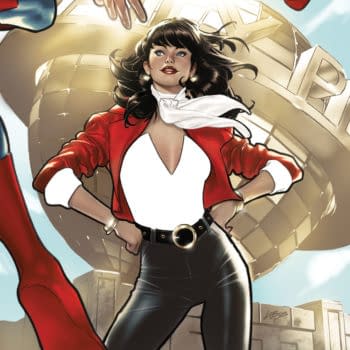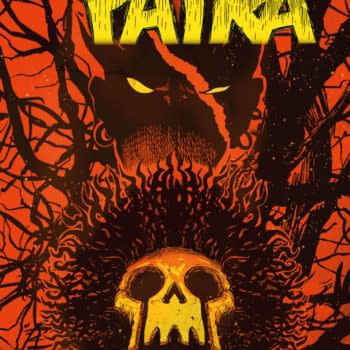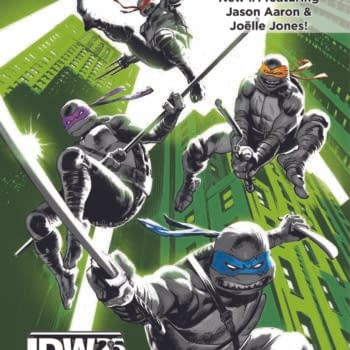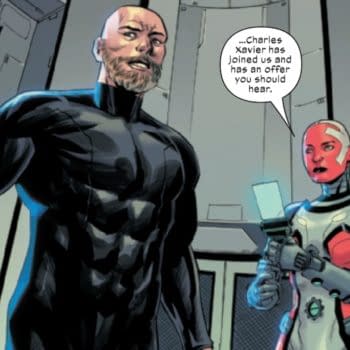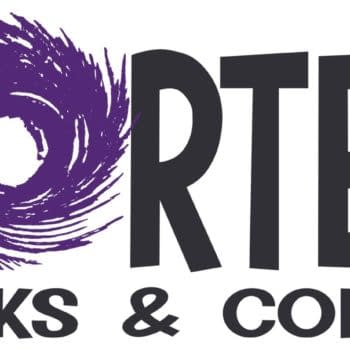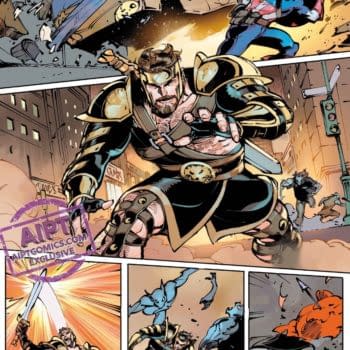Posted in: Comics | Tagged: Comics, idw, popeye, roger langridge
Tom Neely: Popeye, Danzig and The Devil

Tom Neely has anchors tattooed on his forearms — that's how much he loves Popeye.
For the past few years, Neely has steadily been gathering momentum as one of the most distinctive voices in indie comics, blending wordless surrealistic narratives with imagery that seems torn equally from early animation and heavy metal album covers. So, when he announced in February that he would be joining Roger Langridge on IDW's new Popeye series, it was an exciting prospect. Neely has long drawn influence from E.C. Segar's work, and even paid homage to him in his mini-comic, Doppelgänger.
I spoke to him earlier this week to find out more about his work on Popeye, why the character is so important to him, and why a number of Danzig fans would like to see him killed.
Gavin Lees: You're best known for your horror and philosophical comics. What appeals to you about Popeye?
Tom Neely: Popeye was one of the first comic strips that I really latched onto, about 12 years ago when I was in grad school, studying painting. Through studying Philip Guston — one of my favourite painters — I found that he was very influenced by early comic strips, like George Herriman's Krazy Kat; Mutt and Jeff, and stuff like that. So, I started studying old comic strips at that time. When I found Segar's Popeye, it really grabbed me. Also, at the same time, I had been studying animation to try and get a job at Disney after school, because I had some friends who worked there. I was teaching myself how to animate, and I fell in love with the Fleischer Studio cartoons, who did the original black-and-white Popeye and Betty Boop. I just really loved that animation style. In a very short time-span, I fell in love with two different aspects of Popeye that were both informing a lot of what I was trying to do in comics and animation at the time.

GL: Do you think there's something about Segar's style that lends itself particularly well to horror? It always struck me that characters like the Sea Witch or Merlock Jones were incredibly creepy, since his style was so simple, and innocent-looking.
TN: I think there's a lot of creepiness in comics, whether it's intended or not. What always appealed to me about Segar was that, looking at them panel-by-panel like paintings, revealed a lot of subtleties in the composition that were really strange, or creepy. I think that's what The Blot grew out of. I was doing these paintings of the Blot character and they were drawn in a Floyd Gottfredson style, but they were all about distilling a creepy moment in what could have been a funny comic — somebody walking off-panel or something being set in an awkward place — just distilling these moments and trying to draw out the pathos and the creepiness, the psychological horror of existence.

TN: There were two things going on. One was that I was in the middle of working on my longer book, The Wolf, which was not very comics-based, and I just wanted to draw something more comicbooky, so I took a break to draw Doppelgänger really quickly. I had always wanted to do a Popeye story, so I thought I may as well do my own surrealistic Popeye. I was looking through a bunch of my old Popeye comics and there was a 1960 cover by Bud Sagendorf, from issue 56, and it's Popeye punching-out another Popeye. So, the cover of my comic is based on that cover, but in that comic it's a robot Popeye that he's fighting. I've always loved the idea of doppelgängers, so that cover stood out to me and it became the inspiration for my own surrealist comic where he just beats up a bunch of doppelgängers. It has a lot of similarities to The Blot in some of the imagery. That was intentional, since I wanted to have fun with that book and just spend a week drawing comics before getting back to work on The Wolf. It was just a side diversion where I didn't put a whole load of thought into it, I just had fun with it.
GL: But drawing Popeye comics was something that you actively pursued, right? It was shortly after that that you launched a Facebook campaign to become the artist on the new series.

But at the time, my friend Dylan [Williams, founder of Sparkplug Books] was in the hospital, and I was travelling back-and-forth a lot to Portland, so I didn't have time for the try-outs. Then later, I found out that they had found somebody else to do the series. So, I thought, "That's fine. I've already done my Popeye." But, during that time, when I didn't have time to draw the try-out pages, I kinda still wanted to do it, but I wanted to do it my own way, instead of the Segar way. That was when I started the Facebook campaign as a joke, because sometime — about a year earlier — I saw Noah Van Sciver had done a similar thing, because he wanted to draw Howard the Duck comics. So, I was inspired by him, and it was intended as a joke towards Craig Yoe… but I don't think he liked it too much. [Laughter]

GL: Are they letting you do your own style of Popeye now? Or are they still insisting on it being on-model with Segar?
TN: They wanted it pretty much on-model, so I did my stuff a lot closer to Segar's style. It's not as elongated and rubbery and weird as my Doppelgänger, but it's still me. Rather than trying to copy Segar's style, I just tried to absorb it and do my own thing with it. There's a lot more "me" in it than you might see in some other Segar clones, but it's still trying to draw more in that style than I've done in the past.
GL: What it's like to work under Craig Yoe's stewardship? How much control does he have over the book? You had mentioned a "they" earlier, who wanted the comic drawn in more of a Segar style.
TN: There are a bunch of editors involved in the book. Craig is the person overseeing the project and picking the people involved, but it also needs to go through IDW's editors and King Features Syndicate approvals. There's a bunch of other people involved — I don't even know who they are — that have to approve everything being done. Craig and his wife, Clizia, are the ones that I've dealt with directly… and they're the ones dealing with IDW and King Features.
The editorial process was pretty smooth, actually. At first I had a few minor notes about proportions of things needing to be a little closer to Segar's style. But, once I got a couple of pages done, I got into the swing of things and everything went pretty smoothly.

TN: Yeah, Roger Langridge is writing the whole Popeye series. It's not the first time I've worked with a writer, but it's the first I've done in a while. I did a couple of adaptations for Graphic Classics, and I've been working a little bit with Matt Maxwell, who publishes his own Strangeways series of horror comics. I've done some other stuff in the past, but most of my stuff has been solo, and this is my first pro job with a writer.
It's been interesting; I've really enjoyed it. Roger's a great writer and it was good to bounce ideas off him to get into the flow of how the real comics world works, instead of my usual indie comics.
GL: What's the collaboration between you and Roger like? Are you just picking up scripts that were intended for Bruce Ozella [the artist on Popeye #1], or is he writing with you in mind?
TN: No, he wrote the first four scripts without even knowing who the artists were going to be on any of them. Originally, it was just going to be Bruce Ozella who was going to draw the whole series, but they brought in other people for scheduling reasons. I think Ken Wheaton is the other artist doing part of issue two — he does the first half, and I do the Sappo story — and I did all of issue three, then I think Bruce is back on issue four. I know Roger is now writing more scripts, because they just asked me if I wanted to do issue five, so I'm going to do the Sappo story in that one, but not the whole issue.

TN: I don't think so. I'd like it to be, but unfortunately it doesn't pay well enough for me to be able to do it full-time. So, I'm going to do another five-page Sappo story in issue five. I'd like to still be involved in the series somehow, either doing covers or back-up stories occasionally, but it's too much work and not enough pay for me to afford my living situation… L.A. is expensive! It's unfortunate, because it was fun, and I think it could be a dream job to do Popeye full-time, but I have to go back to animation, so I can stay in my house. Comics loses again, because comics never pays well enough.
GL: You and Roger are working on something else, too, which is a Merciful Fate tribute. Is that right?
TN: Yeah, Mark Rudolph is publishing an anthology of Merciful Fate comics — I was actually working on mine today. I'm not collaborating with Roger on that, we're just both in the anthology. I think Roger did a one-page thing, and I'm doing a six-page short story. There's a bunch of other cool people involved, and it looks like it'll be a cool book. I think he's looking to debut it at SPX this year.

TN: From what I've seen so far, it's adaptations of songs, or tribute art to Mericful Fate. Mine is partially illustrating a song, and then it turns into something else, more of a personal story. The overall book is a whole range of different things.
GL: Now, another music-inspired project that you've been involved in is Henry & Glenn Forever —a romance comic about Glenn Danzig and Henry Rollins in a domestic partnership, which you're co-publishing with Cantankerous Titles. While Popeye sold well, it's my understanding that Henry and Glenn has sold over 50,000 copies. Is that right?
TN: Yeah, so far it's sold over 60,000.
GL: That's almost unprecedented for a self-published, indie comic — that's more than an issue of the X-Men sells!
TN: I think so, too, and the comics media at large has largely ignored it. Some people in comics love it, but most all of the success of that book has been how well it's done outside of normal comics channels — record stores, and musicians that are fans of Henry and Glenn, the real people. So, it really took off outside of the normal market. It's been astounding to watch happen, and baffling! Also, it's been baffling to me why the new issue is out and Joe Biel (my co-publisher on this book) was saying to me that he was getting ignored as far as sending out PR to comics outlets. So, it's largely overlooked as some dumb fluke of a book in the comics world. Meanwhile, while nobody's watching, it's selling tens of thousands of copies to non-comics fans. Go figure! It's certainly interesting to watch.

TN: Well, like Popeye, my idea was to do a four-issue miniseries, and then we'd collect it as a book, and add more stuff. Probably at this point, after I've gotten a lot of people on-board and other artists involved, I could expand it to a six-issue story arc, but I think I'd rather just save it and have the collected edition have a bunch of extras.
The second issue is underway, which we're trying to get done in time for SPX. It's going to have me continuing my story — that'll be serialized throughout each of the four issues, then there'll be other artists doing one-off strips. The first issue had Benjamin Marra and Ed Luce doing short stories, and the second issue will have Josh Bayer and Mark Rudolph, and then we've got some other people planned for future issues like Janelle Hessig, Virginia Paine, J.T. Dockery, as well as a lot of people doing pin-up art — everybody from Michael Deforge and Max Clotfelter to Becky Cloonan and Farel Dalrymple — it's going to be a really weird mixture of all my favourite indie comics stuff.
GL: Are you finding that most people who come to the project are genuine fans of Danzig and Rollins?
TN: Yeah, I've been asking a lot of people whose work I like, and kind of gauging their reaction to the question, "Would you like to do something?" Some people are super-enthusiastic, and are just like, "Yeah, I love those two guys! I love the book and I want to do something!" Part of the reason I thought to do this new mini-series was that after the first book came out, at the Stumptown Comics Fest in 2009, I had a table next to Ed Luce and he was the first person I showed it to. He just flipped out and said, "If you ever do more, you have to let me do something!" So, I've been asking a lot of cartoonists, and the ones that are really enthusiastic about Henry and Glenn and the comic itself are the ones that I'm using for the most part. There are a few others that I've prodded into contributing, because I thought they'd do something good, whether they know it or not. But for the most part, I've been trying to get people that are fans of the actual Rollins and Danzig, so they can bring that knowledge to their take on the storytelling.
GL: I think it would be very easy for it to be a cheap gag, but it never feels that way. It seems that most of the contributors are doing it out of genuine admiration.
TN: Yeah, I don't want anything mean-spirited. I want people who love them enough to be respectful, but also love them enough to realize how ridiculous they are! [Laughter] There have been some people I've asked who, I think, were too much of a fan and they didn't like the concept. I don't want that anyway, I want people that are willing to make fun of their idols. As Sonic Youth said – "Kill yr idols."
GL: It seems surprising that you've had so much positive feedback from the book. Are you aware of any negative responses, maybe being accused of homophobia because of the concept?
TN: Not personally. I've heard some of that through the grapevine from certain people, but I've also had people tell me that there's crazy Danzig fans out there that hate me and curse me on message boards. At first I was worried that it might be seen as homophobic, because the original book is made by four straight guys. But I've always approached the book as wanting to just portray them as a normal couple. So, I don't feel like I've done anything homophobic with the book. I certainly hope not. But you can't control how people react to things, so there may be some misinterpretations out there. But I haven't really encountered anything personally, any negative reactions. Either people are really into it, or they're just like, "M'eh…" [Laughter] I've had some people approach me at conventions thinking I'm a gay artist because of the book — they obviously haven't seen The Wolf — and I take that as a compliment.
GL: Have you heard from either Danzig or Rollins? I know that J. Bennett from Decibel Magazine interviewed Danzig about it, but have either of them contacted you?
TN: No, not personally. Actually, there was the L.A. Zinefest back in February, and I was there and so was Henry Rollins. He was doing a talk, but we never ran into each other unfortunately, but we were in the same building at that point. But, they've never confronted us. There is a Nardwuar interview with Rollins where he says like, "You know, whatever, there's the First Amendment — people can do what they want." But he pleads ignorance to the content of the book, so it's kinda funny.
GL: So, what's next for you, after Popeye. Have you got any new personal projects that you're working on?
TN: Yeah, I've got a few different things. I'm working on a couple of short stories for some anthologies that I've been asked to do. I've had this ongoing series of one-panel paintings/comics things that I've been working on for a couple of years, some of which I've run on the Study Group website, under the title I've Just Figured It All Out. I plan to continue that until it feels like it's done, and then collect it as a book.
I've got my next graphic novel written, but I don't know when I'm going to start drawing it yet. I've been trying to find a way to pay the bills lately. I don't have enough time to make my own comics at the moment.
GL: What's the new graphic novel going to be about?
TN: It's called The Devil, but I don't really know how to describe it beyond that. [Laughter]
GL: Is it going to be another wordless story?
TN: It's not going to be completely wordless, but that may change, it might end-up completely wordless. It's more like The Blot, it has minimal use of wordage.
GL: So, will it be more in a comics format, like The Blot?
TN: Yeah, it's going to be more of a combination. I'm going to change it up again. It probably won't resemble either of my last two books.
Gavin Lees is the editor of Graphic Eye and writes about comics for Scream Magazine.






